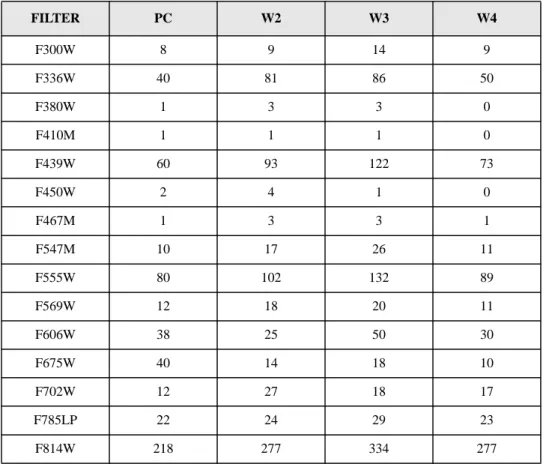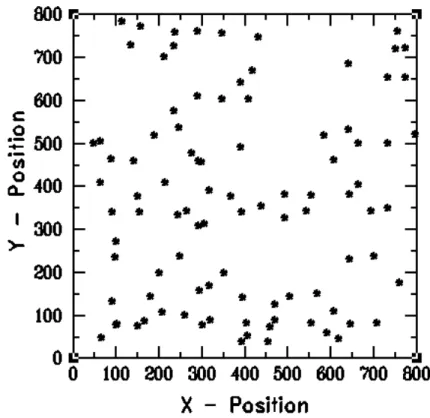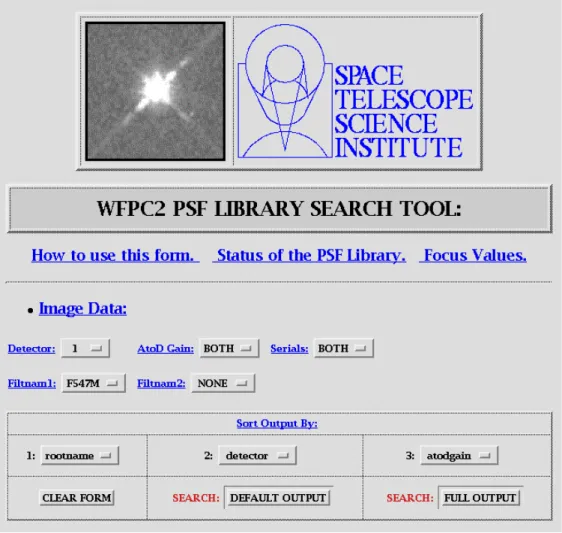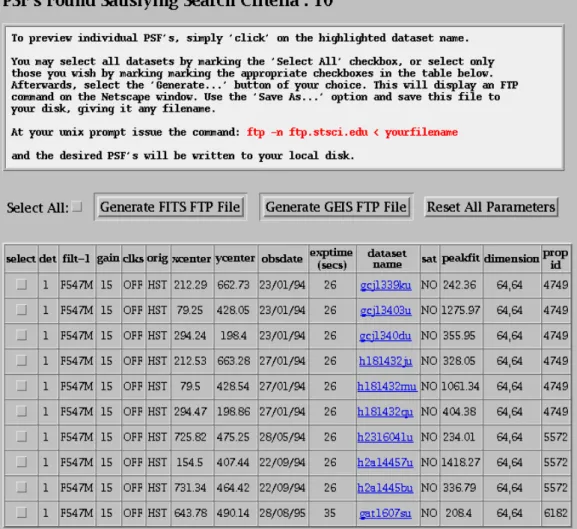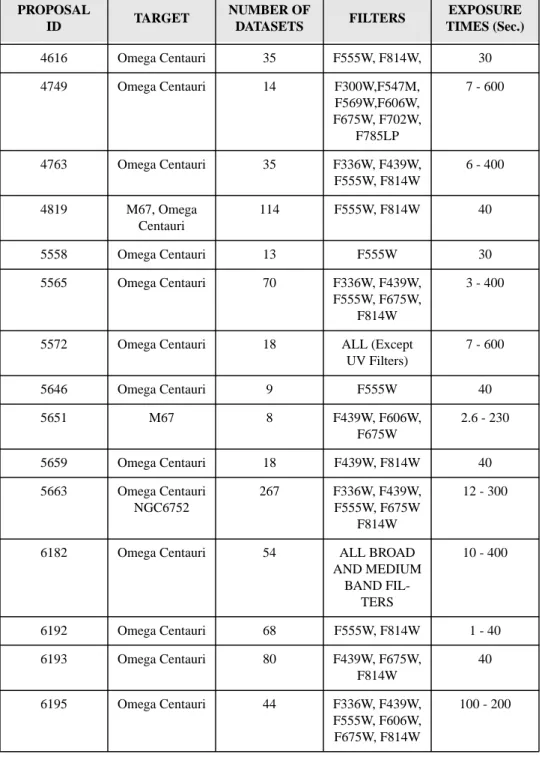The WFPC2 PSF Library
Michael S. Wiggs, Sylvia Baggett, Jean Surdej, and Calvin Tullos -September 23, 1997
ABSTRACT:
We describe the development of the WFPC2 PSF Library. The extraction of observed Point Spread Functions from standard calibration observations, as well as the creation of their associated header files are discussed. We then describe the development of the WWW-based PSF Library Search Tool, and use of the Tool.
1. Introduction
The WFPC2 PSF Library is designed to provide observers with easy access to a selec-tion of observed PSFs, taken in most WFPC2 filters, and in various posiselec-tions across each chip. Many of the PSFs were extracted from images of the clusters Omega Centauri and M67, which were imaged as part of STScI’s ongoing WFPC2 Calibration Observations. These observations provided stellar images of various intensities, saturation levels, and positions across the chips. Only isolated, non-overlapping PSFs were selected.
In the future, we plan to extract PSFs from the calibration observations of the single white dwarf stars A+81D266, BD+75D325, GRW+70D5824, and Feige110, from
selected, public GO data, as well as from the remaining observations of the clusters men-tioned previously.
2. Generation of the PSFs
The PSF images were extracted from archival, pipeline processed WFPC2 images, with no further processing, and generally no cosmic-ray rejection. To identify PSF candi-dates, the observations were examined by eye. The PSF stars had to be well separated from other stars and have a peak intensity of no less than 150 DN; there was no imposed upper limit on any star’s intensity.
For all stars meeting these simple selection criteria, the IRAF tool imexamine was used to fix the star’s position and calculate the peak intensity (a Gaussian fit, in DN). An estimate was made of the background level on the chip, by determining the average within 3
20x20 pixel regions, free from cosmic rays. The resulting estimate is given in the BACK-GND keyword in the PSF header.
The PSF positions and intensities were used to:
1. Determine the DN value of the peak pixel from image statistics (not the fit from imexamine), and then define the size of the extracted image. For peak intensities less than 3500 DN, the extracted image is 64x64 pixels, centered on the PSF; greater than 3500 DN, the image is 128x128 pixels.
2. Extract the image sections as separate images with individual headers, comprised of the original WFPC2 header, plus new PSF specific keywords, listed in the table below.
ORIGIN Data Source (HST, TINYTIM, or COMPOSITE) XCENTER X coordinate of PSF center on chip YCENTER Y coordinate of PSF center on chip XCORNER X pixel of (1,1) corner in PSF image YCORNER Y pixel of (1,1) corner in PSF image
RA_PSF RA of PSF star (deg, J2000) DEC_PSF Dec of PSF star (deg, J2000) PEAKINT Peak intensity at xcenter, ycenter PEAKFIT Peak of Gaussian fit SATURATD Is PSF saturated? (Y or N) BACKGND Background (in DN) SPECTRAL Spectral type of source, if known
REFSPEC Reference spectrum, if known T306 Secondary mirror temperature (degrees Celsius) T307 Secondary mirror temperature (degrees Celsius) T308 Secondary mirror temperature (degrees Celsius) T309 Secondary mirror temperature (degrees Celsius) V2_RMS V2 Axis RMS (milli-arcsec)
V2_P2P V2 Axis peak to peak (milli-arcsec) V3_RMS V3 Axis RMS (milli-arcsec)
V3_P2P V3 Axis peak to peak (milli-arcsec) GUIDEACT Actual guiding mode at end of GS Acquisition RELFOCUS Relative focus (in microns)
3. Recompute the minimum and maximum data values and the “good” minimum and maximum data values, and update the PSF headers.
Any PSF image with saturated pixels (bitflag = 8, in the original calibration image’s data quality (.c1h) file), had those pixel values replaced with a value of -100. This will allow users to quickly identify saturated pixels within the PSF.
3. Status of the PSF Library
To date there are 2701 PSF images available in the PSF Library. The table below lists the current distribution of PSFs by filter and chip.
Table 2. Status of PSF Library by filter and chip.
4. PSF Relative Focus Information
One of the new PSF header keywords provides a value for the relative focus
(RELFOCUS). This was done to provide users with a general idea of the focus of HST at the time of the PSF observation. Thus, users can use PSFs at or near the same focus as their own observations.
FILTER PC W2 W3 W4 F300W 8 9 14 9 F336W 40 81 86 50 F380W 1 3 3 0 F410M 1 1 1 0 F439W 60 93 122 73 F450W 2 4 1 0 F467M 1 3 3 1 F547M 10 17 26 11 F555W 80 102 132 89 F569W 12 18 20 11 F606W 38 25 50 30 F675W 40 14 18 10 F702W 12 27 18 17 F785LP 22 24 29 23 F814W 218 277 334 277
Presently, nearly half of the PSFs in the Library have RELFOCUS values determined from an average fit of the focus monitoring data based on the “phase-retrieval” method, with no correction for orbit-to-orbit variations in the focus, (known as “breathing”). No breathing correction could be performed because the observations were made prior to July 1995, when temperature data became readily available. The other half of the PSFs were taken after July 1995, and have the “breathing” correction applied to the averaged phase-retrieval focus values. See Instrument Science Report OTA-18 for details on the focus his-tory of HST and the “breathing” correction (Casertano, 1995). The r.m.s. scatter around the average fit is roughly +/- 2 microns, while the scatter for points with the breathing cor-rection applied is close to +/- 1.3 microns.
Within the headers of the PSFs, we have also included the secondary mirror
temperatures (T306, T307, T308, and T309 keywords), if known. Thus, if a particular PSF has a value other than 0.00, the breathing correction has been applied.
Also available from the PSF Library Help Page is a table containing the Modified Julian Date (MJD), and the averaged phase-retrieval focus values (with no breathing cor-rection applied), to provide users with an estimate for the focus of their science image.
5. PSF Library Search and Retrieval Tool
In order to make the PSF images easily accessible to WFPC2 users, we opted for a Web-based search and retrieval tool, with the PSF images stored and available on-line. The tool was designed to be as flexible as possible, allowing the user to search for desired PSFs using virtually any combination of criteria. The output of this search can also be sorted according to the user’s needs .
There are four basic steps to using the tool:
1. Define a subset of PSFs using qualifiers on the main page. 2. Select for retrieval a subset (or all) PSFs from the tabular output
3. Request generation of an ftp command file for retrieval of the selected PSFs 4. Save the command file to local disk, and run it at the user’s leisure.
The Tool is accessible at the following WWW address:
The page has an extensive help file as well as a status page, listing the number of PSFs per filter and chip, and also plots showing the X-Y positions of the PSFs on the original images (see Figure 1). The PSF files can be retrieved in either FITS or GEIS formats.
Figure 2. A portion of the WFPC2 PSF Library Web Page.
Figure 2 displays a portion of the PSF page, with parameters set to search for all PSFs for filter F547M, in the PC, with any gain, and both serials. There are many other key-words that can be used as qualifiers, such as observation date, exposure time, if the PSF is saturated, peak intensity, X,Y position (with search radius), as well as jitter. The user can sort the output according to any criteria, in this example the output will be sorted by dataset name, detector, and gain. The result of this search is in the “default output” format and is illustrated in Figure 3.
The output page allows the user to preview the PSF image, by “clicking” on the highlighted dataset name. It also allows for the selection of either all or just a few PSFs to be marked for retrieval. The PSFs can then be downloaded to the user’s machine in either GEIS or FITS format.
Figure 3. Output from a search of the PSF Library.
The PSF Library is being continually updated with new PSFs. However, some users may find no appropriate PSFs in the Library. In this case we recommend using archival data, either calibration or public GO data as a source of observed PSFs. Table 3 lists some of the calibration proposals which could provide useful PSFs. Another alternative is to use TinyTim, a program to generate theoretical PSFs. Tiny Tim can be accessed at:
Table 3. Calibration Proposals useful for generating PSFs.
6. Acknowledgements
We would like to thank the following people for useful comments and suggestions: Stefano Casertano, Calvin Tullos, Matt Lallo, and Tim Kimball.
PROPOSAL ID TARGET NUMBER OF DATASETS FILTERS EXPOSURE TIMES (Sec.) 4616 Omega Centauri 35 F555W, F814W, 30 4749 Omega Centauri 14 F300W,F547M, F569W,F606W, F675W, F702W, F785LP 7 - 600 4763 Omega Centauri 35 F336W, F439W, F555W, F814W 6 - 400 4819 M67, Omega Centauri 114 F555W, F814W 40 5558 Omega Centauri 13 F555W 30 5565 Omega Centauri 70 F336W, F439W, F555W, F675W, F814W 3 - 400
5572 Omega Centauri 18 ALL (Except UV Filters) 7 - 600 5646 Omega Centauri 9 F555W 40 5651 M67 8 F439W, F606W, F675W 2.6 - 230 5659 Omega Centauri 18 F439W, F814W 40 5663 Omega Centauri NGC6752 267 F336W, F439W, F555W, F675W F814W 12 - 300
6182 Omega Centauri 54 ALL BROAD AND MEDIUM BAND FIL-TERS 10 - 400 6192 Omega Centauri 68 F555W, F814W 1 - 40 6193 Omega Centauri 80 F439W, F675W, F814W 40 6195 Omega Centauri 44 F336W, F439W, F555W, F606W, F675W, F814W 100 - 200
